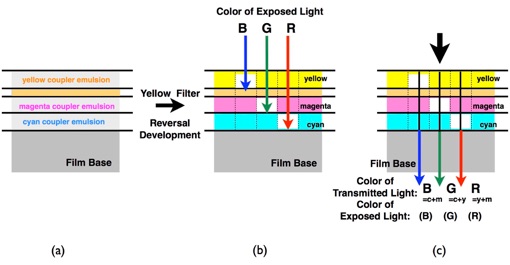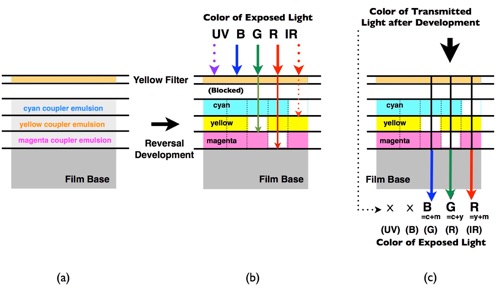Atelier Bonryu(E)
infrared photography


Atelier Bonryu(E)
infrared photography







Laboratory: Infrared Photography
Remark #1 Infrared Photography
by a Film Camera


When the infrared photography was devised, only a monochromatic film was available to take an infrared photograph. An infrared color film was, first, brought out by Eastman Kodak Company, and after that infrared color films have been put on market by Konishiroku (Konica), Ilford Limited, and Rollei GmbH. Infrared color films of Kodak and Konica have retired already and only those of Ilford and Rollei are now available. When Kodak released the infrared color film a concept of “false color” was introduced. Though the original meaning of “false color” in the field of the photography is spurious color which appears due to some reasons but does not exist in the object, in the case of the infrared photography it means color rendering methods to display images which have different visible color or do not have any color by considering the wavelength of light and the color space. Therefore, the original “false color” has a negative meaning to deteriorate a photograph but the “false color” of the infrared photography has a positive meaning to make a photograph more beautiful and/or bring out more information from an infrared photograph.
Structure of Conventional Color Film for Visible Light: Before explaining the structure of the infrared color film we describe briefly the structure of the conventional color film used for taking a visible light photograph. In both the monochromatic and the color films photosensitive substance is a silver halide molecule. Though in the case of a monochromatic film a silver atom generated from the exposed silver halide molecule forms a final image of the photograph, in a color film an exposed silver halide molecule is exchanged with a pigment molecule in the emulsion to make a color image and finally the silver atom is removed. But the detail of these chemical processes have nothing with the present matters of interest, i.,e., the comparison between “a conventional visible light color film” and “an infrared color film”. Present important question is how are three layers colored when a light enters the film. These three layers absorb lights with different wavelengths, i.e., lights with blue, green, and red colors (Fig.R1-1). By the way, the structures of a negative color film and the reversal color film are basically the same. In the case of a negative color film each layer is colored by the complementary color of the absorbed light. On the other hand in the case of the reversal color film the complementary colors corresponding to the layers which do not absorb the light are colored by the reversal development and finally the color of the transmitted light becomes the same color of the object. If we express the structure more concretely; the upper, the middle, and the lower layers of a film detect, respectively, the colors of blue (B), green (G), and red (R) lights, where the pigments of yellow (Y), magenta (M), and cyan (C) are included, respectively. As the colors, Y, M, C are complementary colors of the colors, B, G, R, the image on this film appears as a negative color image, when the conventional development is carried out. Meanwhile, though the structure of a reversal color film is almost the same as the negative color film, development becomes more complicated with the increase of one additional process (reversal development). When one layer of a reversal color film is exposed and developed layers other than the exposed layer is colored. For example, if the uppermost layer (blue layer) is irradiated by blue light and developed, in the case of a negative color film this layer becomes yellow but in the case of a reversal color film this layer become transparent and colorless, and the middle and the lowermost layers become magenta and cyan, respectively. As a result the film becomes blue. By the way as the basic sensitized material silver halide is sensitive to the blue light, the middle and the lowermost layers are exposed by the blue light. To avoid it a yellow filter is placed between the uppermost and the middle layers.
Figure R1-1 The structure of a color reversal film for the visible light
(a) The structure before exposure. (b) The structure after the film is exposed and developed. (c) Color of the transmitted light through the exposed and developed color reversal film.
Structure of Infrared Color Film: Basically an infrared color film is composed of three layer structure as the conventional color film for the visible light. The most important feature of the infrared color reversal film is that correspondence between the color of exposed light and the transmitted color of the developed film differs from that of the conventional reversal color film for the visible light photography. Figure R1-2 shows the structure of an infrared color reversal film, such as Kodak Ektachrome Infrared AERO Film Type 8443. In this film three layers to be exposed to the infrared, red, and green are piled up in this sequence and after development these layers become cyan, yellow, and magenta, respectively. However, in the case of the reversal development the color of the transmitted light is determined by the colors of the layer other than the exposed layer. Therefore, when the film is exposed to the infrared, the red, and the green lights, the colors of the light transmitted through this film are, respectively, yellow and magenta (red), magenta and cyan (green), and cyan and yellow (blue).


Figure R1-2 The structure of an infrared color reversal film.
(a) The structure before exposure. (b) The structure after the film is exposed and developed. (c) Color of the transmitted light through the exposed and developed color reversal film.
